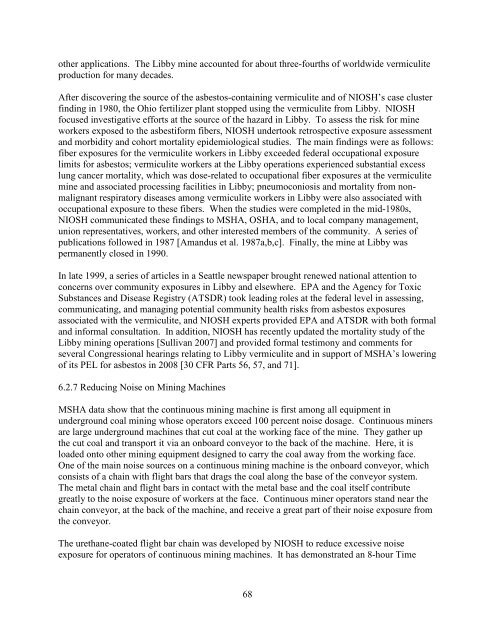One Hundred Years of Federal Mining Safety and Health Research
One Hundred Years of Federal Mining Safety and Health Research
One Hundred Years of Federal Mining Safety and Health Research
- No tags were found...
You also want an ePaper? Increase the reach of your titles
YUMPU automatically turns print PDFs into web optimized ePapers that Google loves.
other applications. The Libby mine accounted for about three-fourths <strong>of</strong> worldwide vermiculite<br />
production for many decades.<br />
After discovering the source <strong>of</strong> the asbestos-containing vermiculite <strong>and</strong> <strong>of</strong> NIOSH’s case cluster<br />
finding in 1980, the Ohio fertilizer plant stopped using the vermiculite from Libby. NIOSH<br />
focused investigative efforts at the source <strong>of</strong> the hazard in Libby. To assess the risk for mine<br />
workers exposed to the asbestiform fibers, NIOSH undertook retrospective exposure assessment<br />
<strong>and</strong> morbidity <strong>and</strong> cohort mortality epidemiological studies. The main findings were as follows:<br />
fiber exposures for the vermiculite workers in Libby exceeded federal occupational exposure<br />
limits for asbestos; vermiculite workers at the Libby operations experienced substantial excess<br />
lung cancer mortality, which was dose-related to occupational fiber exposures at the vermiculite<br />
mine <strong>and</strong> associated processing facilities in Libby; pneumoconiosis <strong>and</strong> mortality from nonmalignant<br />
respiratory diseases among vermiculite workers in Libby were also associated with<br />
occupational exposure to these fibers. When the studies were completed in the mid-1980s,<br />
NIOSH communicated these findings to MSHA, OSHA, <strong>and</strong> to local company management,<br />
union representatives, workers, <strong>and</strong> other interested members <strong>of</strong> the community. A series <strong>of</strong><br />
publications followed in 1987 [Am<strong>and</strong>us et al. 1987a,b,c]. Finally, the mine at Libby was<br />
permanently closed in 1990.<br />
In late 1999, a series <strong>of</strong> articles in a Seattle newspaper brought renewed national attention to<br />
concerns over community exposures in Libby <strong>and</strong> elsewhere. EPA <strong>and</strong> the Agency for Toxic<br />
Substances <strong>and</strong> Disease Registry (ATSDR) took leading roles at the federal level in assessing,<br />
communicating, <strong>and</strong> managing potential community health risks from asbestos exposures<br />
associated with the vermiculite, <strong>and</strong> NIOSH experts provided EPA <strong>and</strong> ATSDR with both formal<br />
<strong>and</strong> informal consultation. In addition, NIOSH has recently updated the mortality study <strong>of</strong> the<br />
Libby mining operations [Sullivan 2007] <strong>and</strong> provided formal testimony <strong>and</strong> comments for<br />
several Congressional hearings relating to Libby vermiculite <strong>and</strong> in support <strong>of</strong> MSHA’s lowering<br />
<strong>of</strong> its PEL for asbestos in 2008 [30 CFR Parts 56, 57, <strong>and</strong> 71].<br />
6.2.7 Reducing Noise on <strong>Mining</strong> Machines<br />
MSHA data show that the continuous mining machine is first among all equipment in<br />
underground coal mining whose operators exceed 100 percent noise dosage. Continuous miners<br />
are large underground machines that cut coal at the working face <strong>of</strong> the mine. They gather up<br />
the cut coal <strong>and</strong> transport it via an onboard conveyor to the back <strong>of</strong> the machine. Here, it is<br />
loaded onto other mining equipment designed to carry the coal away from the working face.<br />
<strong>One</strong> <strong>of</strong> the main noise sources on a continuous mining machine is the onboard conveyor, which<br />
consists <strong>of</strong> a chain with flight bars that drags the coal along the base <strong>of</strong> the conveyor system.<br />
The metal chain <strong>and</strong> flight bars in contact with the metal base <strong>and</strong> the coal itself contribute<br />
greatly to the noise exposure <strong>of</strong> workers at the face. Continuous miner operators st<strong>and</strong> near the<br />
chain conveyor, at the back <strong>of</strong> the machine, <strong>and</strong> receive a great part <strong>of</strong> their noise exposure from<br />
the conveyor.<br />
The urethane-coated flight bar chain was developed by NIOSH to reduce excessive noise<br />
exposure for operators <strong>of</strong> continuous mining machines. It has demonstrated an 8-hour Time<br />
68
















